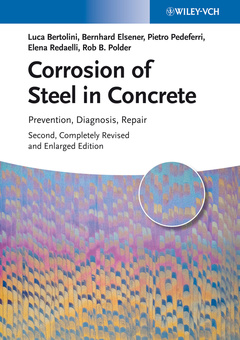Corrosion of Steel in Concrete (2nd Ed.) Prevention, Diagnosis, Repair
Auteurs : Bertolini Luca, Elsener Bernhard, Pedeferri Pietro, Redaelli Elena, Polder Rob B.

The book examines the different aspects of corrosion of steel in concrete, starting from basic and essential mechanisms of the phenomenon,
moving up to practical consequences for designers, contractors and owners both for new and existing reinforced and prestressed concrete
structures. It covers general aspects of corrosion and protection of reinforcement, forms of attack in the presence of carbonation and chlorides,
problems of hydrogen embrittlement as well as techniques of diagnosis, monitoring and repair. This second edition updates the contents with
recent findings on the different topics considered and bibliographic references, with particular attention to recent European standards. This
book is a self-contained treatment for civil and construction engineers, material scientists, advanced students and architects concerned with the design and maintenance of reinforced concrete structures. Readers will benefit from the knowledge, tools, and methods needed to understand corrosion in reinforced concrete and how to prevent it or keep it within acceptable limits.
Portland Cement and Hydration Reactions
Porosity and Transport Processes
Blended Cements
Common Cements
Other Types of Cement
TRANSPORT PROCESSES IN CONCRETE
Composition of Pore Solution and Water Content
Diffusion
Capillary Suction
Permeation
Migration
Mechanisms and Significant Parameters
DEGRADATION OF CONCRETE
Freeze -
Thaw Attack
Attack by Acids and Pure Water
Sulfate Attack
Alkali Silica Reaction
Attack by Seawater
GENERAL ASPECTS
Initiation and Propagation of Corrosion
Corrosion Rate
Consequences
Behavior of Other Metals
CARBONATION-INDUCED CORROSION
Carbonation of Concrete
Initiation Time
Corrosion Rate
CHLORIDE-INDUCED CORROSION
Pitting Corrosion
Corrosion Initiation
Corrosion Rate
ELECTROCHEMICAL ASPECTS
Electrochemical Mechanism of Corrosion
Noncarbonated Concrete without Chlorides
Carbonated Concrete
Concrete Containing Chlorides
Structures under Cathodic or Anodic Polarization
MACROCELLS
Structures Exposed to the Atmosphere
Buried Structures and Immersed Structures
Electrochemical Aspects
Modeling of Macrocells
STRAY-CURRENT-INDUCED CORROSION
DC Stray Current
AC Stray Current
High-Strength Steel
Fiber-Reinforced Concrete
Inspection
Protection from Stray Current
HYDROGEN-INDUCED STRESS CORROSION CRACKING
Stress Corrosion Cracking (SCC)
Failure under Service of High-Strength Steel
Metallurgical, Mechanical and Load Conditions
Environmental Conditions
Hydrogen Generated during Operation
Hydrogen Generated before Ducts Are Filled
Protection of Prestressing Steel
DESIGN FOR DURABILITY
Factors Affecting Durability
Approaches to Service-Life Modeling
The Approach of the European Standards
The fi b Model Code for Service-Life Design for Chloride-Induced Corrosion
Other Methods
Additional Protection Measures
Costs
CONCRETE TECHNOLOGY FOR CORROSION PREVENTION
Constituents of Concrete
Properties of Fresh and Hardened Concrete
Requirements for Concrete and Mix Design
Concrete Production
Design Details
Concrete with Special Properties
CORROSION INHIBITORS
Mechanism of Corrosion Inhibitors
Mode of Action of Corrosion Inhibitors
Corrosion Inhibitors to Prevent or Delay Corrosion Initiation
Corrosion Inhibitors to Reduce the Propagation Rate of Corrosion
Transport of the Inhibitor into Mortar or Concrete
Field Tests and Experience with Corrosion Inhibitors
Critical Evaluation of Corrosion Inhibitors
Effectiveness of Corrosion Inhibitors
SURFACE PROTECTION SYSTEMS
General Remarks
Organic Coatings
Hydrophobic Treatment
Treatments That Block Pores
Cementitious Coatings and Layers
Concluding Remarks on Effectiveness and Durability of Surface Protection Systems
CORROSION-RESISTANT REINFORCEMENT
Steel for Reinforced and Prestressed Concrete
Stainless Steel Rebars
Galvanized Steel Rebars
Epoxy-Coated Rebars
INSPECTION AND CONDITION ASSESSMENT
Visual Inspection and Cover Depth
Electrochemical Inspection Techniques
Analysis of Concrete
MONITORING
Introduction
Monitoring with Nonelectrochemical Sensors
Monitoring with Electrochemical Sensors
Critical Factors
On the Way to 'Smart Structures'
Structural Health Monitoring
PRINCIPLES AND METHODS FOR REPAIR
Approach to Repair
Overview of Repair Methods for Carbonated Structures
Overview of Repair Methods for Chloride-Contaminated Structures
Design, Requirements, Execution and Control of Repair Works
CONVENTIONAL REPAIR
Assessment of the Condition of the Structure
Removal of Concrete
Preparation of Reinforcement
Application of Repair Material
Additional Protection
Strengthening
ELECTROCHEMICAL TECHNIQUES
Development of the Techniques
Effects of the Circulation of Current
Cathodic Protection and Cathodic Prevention
Electrochemical Chloride Extraction and Realkalization
INDEX
Bernhard Elsener is Professor for materials science at the Faculty of Engineering at the University of Cagliari, Italy, and a lecturer at ETH Zurich, Switzerland. He is an internationally well-known expert on the durability of reinforced and prestressed concrete structures. His extensive research work and numerous publications focus on non-destructive methods to detect and quantify corrosion, the use of new electrically isolated post-tensioning tendons and electrochemical restoration techniques.
Pietro Pedeferri (1938-2008), a graduate in chemical engineering and former Professor of Electrochemistry at the University of Bari, has been Professor of Corrosion and Protection of Materials at the Technical University of Milan since 1983. His work has been mainly concerned with the corrosion of steel in concrete, and he has published more than 300 papers and a dozen books in the field of corrosion and materials technology.
Elena Redaelli is Assistant Professor in the field of materials science and technology at the Polytechnic University of Milan where she teaches Construction Materials to Building Engineering students. Her main scientific interests are connected with the corrosion of steel in concrete, its characterization and methods to prevent and control it. In particular, her research activity has focused on electrochemical techniques in concrete and methods for durability design of concrete structures.
Rob B. Polder is a senior materials scientist at the Netherlands Organization for Applied Scientific Research, and a full pr
Date de parution : 03-2014
Ouvrage de 434 p.
17.8x24.9 cm
Disponible chez l'éditeur (délai d'approvisionnement : 14 jours).
Prix indicatif 176,49 €
Ajouter au panierThèmes de Corrosion of Steel in Concrete :
Mots-clés :
hydrogen embrittlement concrete, reinforced concrete structures, reinforced concrete, reinforced concrete building, carbonation concrete, carbonation corrosion, concrete reinforcement, reinforced concrete standards, reinforced concrete Europe, design reinforced concrete, engineering reinforced concrete


